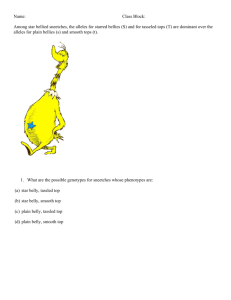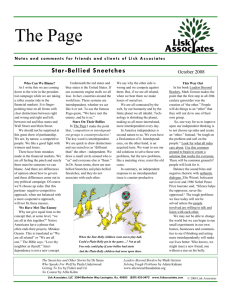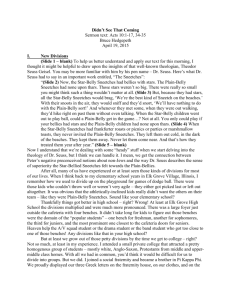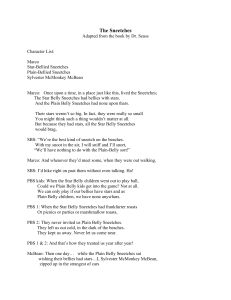Action or Illusion? By K. Clay The food stamp program
advertisement
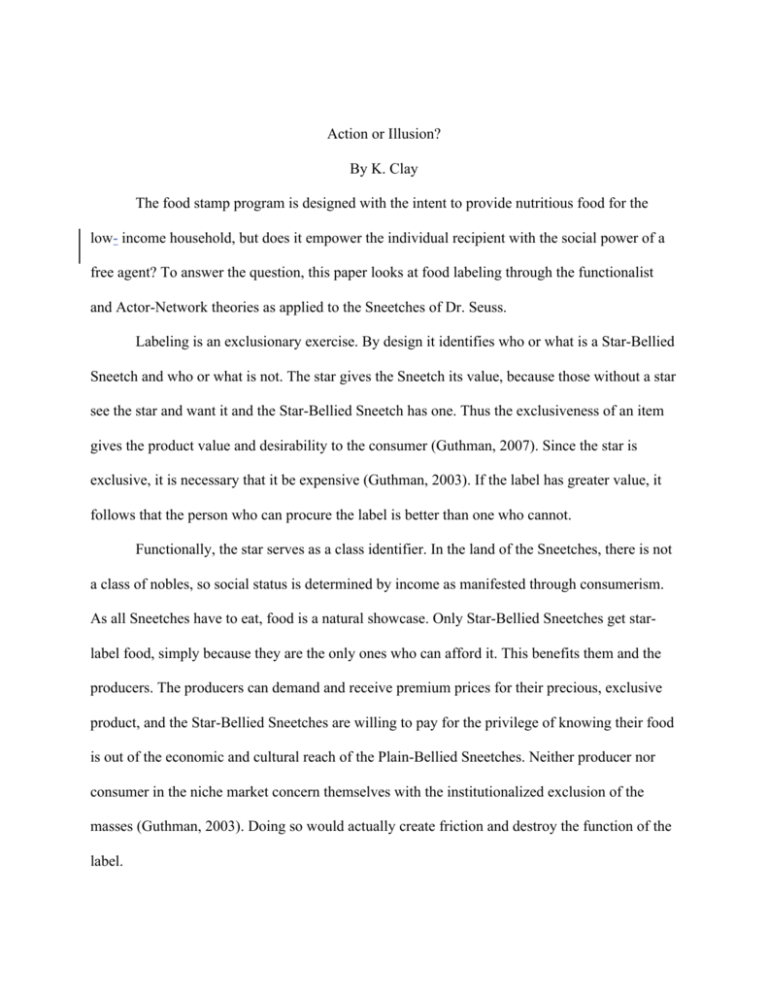
Action or Illusion? By K. Clay The food stamp program is designed with the intent to provide nutritious food for the low- income household, but does it empower the individual recipient with the social power of a free agent? To answer the question, this paper looks at food labeling through the functionalist and Actor-Network theories as applied to the Sneetches of Dr. Seuss. Labeling is an exclusionary exercise. By design it identifies who or what is a Star-Bellied Sneetch and who or what is not. The star gives the Sneetch its value, because those without a star see the star and want it and the Star-Bellied Sneetch has one. Thus the exclusiveness of an item gives the product value and desirability to the consumer (Guthman, 2007). Since the star is exclusive, it is necessary that it be expensive (Guthman, 2003). If the label has greater value, it follows that the person who can procure the label is better than one who cannot. Functionally, the star serves as a class identifier. In the land of the Sneetches, there is not a class of nobles, so social status is determined by income as manifested through consumerism. As all Sneetches have to eat, food is a natural showcase. Only Star-Bellied Sneetches get starlabel food, simply because they are the only ones who can afford it. This benefits them and the producers. The producers can demand and receive premium prices for their precious, exclusive product, and the Star-Bellied Sneetches are willing to pay for the privilege of knowing their food is out of the economic and cultural reach of the Plain-Bellied Sneetches. Neither producer nor consumer in the niche market concern themselves with the institutionalized exclusion of the masses (Guthman, 2003). Doing so would actually create friction and destroy the function of the label. Clay / ANTH 586 / Essay 2 / 2 The rise in desirability of the star-label is also a threat to its function. Plain-Bellied Sneetches cannot afford the premium prices, but want the cultural and social recognition, so they make efforts to acquire the products. Seeing the increased consumer demand, some enterprising Sneetches take a plain-label item and slap a star on it and sell the counterfeit product. Because of this insult to their status, Star-Bellied Sneetches scream that the government must do something to protect The Market from false goods. Producers scream that the government must act because counterfeits lower the value of the real item, and it reduces their profits. So the government steps in and regulates what is or is not a star-labeled product and create a certifying authority to insure that the regulations are adhered to by producers (Guthman, 2007; Gouveia & Juska, 2002). Now anyone, in theory, can get certified and provide The Market with star-labeled products. However, this too is exclusionary of those producers who cannot afford the fees required to procure the right to affix the star-label. Lured on by higher profit per unit, producers make the effort and get certified to label their product with the star. More producers means more supply. More supply means lower prices and less profit per unit. The function of the star-label is no longer valid for either the Star-Bellied Sneetches or the star-label producers. Those who benefit from the functionality of labeling protect it. The Star-Bellied Sneetch consumers protect their elite social status by altering the meaning behind the label. No longer does it simply indicate economic status, but it is imbued with political concerns such as: a starlabeled product uses less synthesized components and is therefore better for the environment (Guthman, 2003). Now the label means that those who purchase star-labeled products care more about the environment and are better citizens than those who purchase non-labeled food products (Guthman, 2003; Julier, 2013). Thus, the elite social status of the Star-Bellied consumer is restored. The producers seek to regain their lost profits by recreating their previous standing with Clay / ANTH 586 / Essay 2 / 3 a new, exclusive label (Howard & Allen, 2010) such as a star with a border, indicating they are even better than star-label and therefore worth the premium price. Through maneuvers such as these, the function of the market system remains a fluid constant. The plebian, Plain-Bellied Sneetches seek inclusion into the ranks of good citizenry. So they appeal to their government officials that ran on the platform of “Star-labels for Every Pot.” These officials have to appease the masses, perhaps because they represent so many votes come re-election time, but they also have the producer lobbyists demanding they remember who donates to their campaign funds. To satisfy both, the politicians work up a plan whereby they will give money every month to the Plain-Belly Sneetches that have none. These Sneetches go home satisfied. Now not only will they be able to purchase the star-label food, but the politician Sneetch told them that their every consumer dollar is of equal political value to the Star-Bellied Sneetches (Howard & Allen, 2010). It appears that being a good citizen just became inclusionary. The producers need their exclusivity as justification for their premium selling price. The agency given the Plain-Bellied Sneetches through government funds threatens to make their products vulgar and of a common value. The elected Sneetches reassure the producer lobbyists that will not come to pass. After all, the monthly allowance the Plain-Bellied Sneetches receive is not sufficient for meeting the star-label prices. Instead, the politician points out, the producers should be pleased for he has just opened a new consumer base for them. They can now sell their products that do not meet Star-label standards of local, humane, or organic standards and the Plain-Bellied Sneetches will purchase them, as there is not a viable alternative (Howard & Allen, 2010). The producers leave, satisfied that money will continue flowing into their pockets from both Plain-Bellied and Star-Bellied Sneetches. Clay / ANTH 586 / Essay 2 / 4 The Star-Bellied Sneetches desire the protection of their elite social standing and political power. They arrive at the politician’s office in a dither. With Plain-Bellied Sneetches now having the means to politically compete through their buying power, they could rearrange the sociopolitical structure through combined BUYcotting. The politicians reassure the frantic StarBellied Sneetches that such an event is improbable. For a BUYcott to be effective, there has to be an alternative (Howard & Allen, 2010) and on the paltry sum the Plain-Bellied Sneetches have to purchase foods, there is no alternative other than the cheapest items. Without alternatives, the Plain-Bellied Sneetches have not expressed anything other than a desire to not starve. The politicians further point out that the Plain-Bellied Sneetches have no time to learn about political issues. They are too busy caring for their young children or working, so political consumer activism by a Plain-Bellied Sneetch is so unlikely as to be nigh impossible. The ability to make consumer choices is still out of reach for the majority (Gouveia & Juska, 2002). The Star-Bellied Sneetches are satisfied; their exclusive status remains intact. At the end of the day, the political Sneetch just laughs. Each of the three groups, producers, Star-Bellied Sneetches, and Plain-Bellied Sneetches, left feeling that they were empowered actors within the social network of the country. None of them realized that neither consumer nor producer had agency, instead the political structure had it all (Trauger, 2009). The politician gives the groups the illusion of agency, but retains the real performative capacity for himself. The others simply scuttle about, tied by their fetishized consumption (Gouveia & Juska, 2002). The politician retained actual power and agency control of the market social network for himself. Food stamps give the illusion of empowering the underprivileged, Plain-Bellied Sneetches. It prohibits the purchase of alcohol and hot, prepared foods, but anything else is left Clay / ANTH 586 / Essay 2 / 5 to the consumer. Plain-Bellied Sneetches now have the means to purchase exclusive Star-label foods so their product choices are just that- their choice. However, the reality is that they have to make low budget purchases in order to eat for the entire month. Some Sneetches binge and eat a fillet mignon, but the remainder of the month they have ramen noodles. The label most of these Plain-Bellied Sneetch consumers look at is the price label. Although they would like to care about the environment, workers conditions, etc., they make their purchase choices based on “what will fill me and my children up for the least amount of money so there is less month left over when the food runs out” (Howard J. , 2014). Food stamps give the Plain-Bellied Sneetches the choice not of what labeled products they wish to consume, but of how many days in a month they would like to eat. Those elite Star-Bellied Sneetch groups, such as producers and governments, who could further assist them to attain higher quality food products, must protect their functionalist positions that further the workings of the free market. Functionalism may be an outdated social theory, but it explains the distribution of power and the retention of power. The newer social theories, such as the Actor-Network Theory are extensions built on the functionalist foundation. Any network that gives agency threatens its own existence by doing so, as agents could then restructure the social-networks. Therefore, in order to maintain control, the network controllers have to give the illusion of agency and a rationale as to why the end result has not changed. In the case of food stamps, they do it by claiming that through their purchases that Plain-Bellied Sneetches want the lower quality food. In the end, consciences abated, tucked in under their soft comforters, the politicians sleep clutching tightly to their Star-Bellied chests, like a beloved teddy bear. Clay / ANTH 586 / Essay 2 / 6 Bibliography Gouveia, L., & Juska, A. (2002). Taming Nature, Taming Workers: Constructing the Separation Between Meat Consumption and Meat Production in the U.S. Sociologia Ruralis, 370390. Guthman, J. (2003). Fast food/organic food: reflexive tastes and the making of 'yuppie chow'. Social & Cultural Geography, 45-58. Guthman, J. (2007). The Polanyian Way? Voluntary Food Labels as Neoliberal Governance. Antipode, 456-478. Howard, J. (2014, November 14). Informal Interview on the SNAP Program in Oregon. (K. Clay, Interviewer) Howard, P. H., & Allen, P. (2010). Beyond Organic and Fair Trade? An Analysis of Ecolabel Preferences in the United States. Rural Sociology, 244-260. Julier, A. (2013). The Political Economy of Obesity: The fat pay all. In C. Counihan, & P. Van Esterik (Eds.), Food and Culture, Third Edition (pp. 546-562). New York: Routledge. Trauger, A. (2009). Social agency and networked spatial relations in sustainable agriculture. Area, 117-128.
